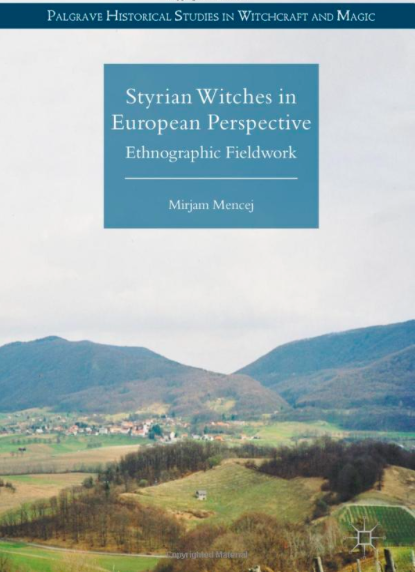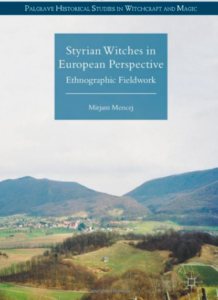

Until the last several decades, historians would have agreed that European witch beliefs had gradually disappeared following the decline of witch trials during the seventeenth century. However, contemporary researchers have effected an historic revision, documenting the persistence of these archaic beliefs into the twentieth century. Jeanne Favret-Saada’s Les Mots, la Mort, les Sorts: La Sorcellerie dans le Bocage, a rural area of northwestern France, broke the ground in 1977. [1] Her anthropological research began by identifying patients in the mental health care system diagnosed with “delusions of persecution by witchcraft” (a psychiatric category in 1960’s France). Following them home after their discharge, she described a triangular pattern constituting the witchcraft discourse: “bewitched” victims, unsure of the identity of their magical persecutor, turned to an “unwitcher,” and together they struggled to identify the witch, who occupied the “shadowy third point of the witch triangle.”[2] This framing of witchcraft events as comprised of two identifiable persons, plus a hazy third, lurking, dangerous and guilty, has been accepted by historians as crucial to understanding the internal logic of traditional witch beliefs systems. Favret–Saada was construed by her informants as an unwitcher (why else would she be so interested in their bewitchments?) and warned that their witches might not welcome her involvement, presumptively aimed against them. After a series of accidents, including a car crash and a serious fall, the Sorbonne anthropologist realized that she had been “caught” in the witch belief system.[3] Over time, she accepted her new role and interpreted “unwitching” as a form of therapy in traditional peasant contexts. Narratives of bewitchment were used “to explain actual life failures, problems and conflicts” in a way that saved the reputation of a household and family. The presumptive magical source of household and agricultural misfortunes could thus be identified and projected outward, preserving the self-worth and integrity of the “bewitched” (Mencej, 203 ff.). Favret–Saada’s work on contemporary witch beliefs in Europe has been followed up by others, especially by Willem de Blécourt, a Dutch historian whose research spans the chronological spectrum from the sixteenthen to twentieth century. He has stressed that witch beliefs extend beyond language or discourse, comprising “a coherent system of concepts, stories and actions” which has survived into the present in many areas of Europe.[4]
It is the actions and beliefs of contemporary rural Slovenians and their recent ancestors that form the subject of Styrian Witches in European Perspective: Ethnographic Fieldwork (2017). Mirjam Mencej is an ethnographer and cultural anthropologist at the University of Ljubljana in Slovenia; beginning in the year 2000, she led a program of field research in southern Styria, a wine growing area otherwise described (for reasons of the “delicate” subject matter) only as “a secluded rural region of eastern Slovenia” (Mencej1). The province of Styria was historically part of the Austro-Hungarian Empire, now split between Austria and Slovenia. The initial goal of Mencej’s project was to record local folklore and legends; to her surprise, the major topic that informants wanted to discuss was witchcraft. Between 2000 and 2015, she and her students conducted interviews with over 270 people between the ages of fifty and ninety, who related episodes of witchcraft accusations and extra-judicial counter-measures occurring throughout the twentieth century.
The Hapsburg province of Stryia had been the scene of classic German style witch trials from the 1540’s through 1670’s, ending only in the 1740’s, fairly late by western European standards. [5] Raising storms, sickness in animals, crop failures and shapeshifting (animal transformation) were repeated elements in these early modern trials. Episodes of floods, poor harvests and outbreaks of disease created the conditions for many such accusations, even as educated elites increasingly rejected both accusations and trials during the eighteenth century Enlightenment. In the nineteenth century, local folklorists collected “witchcraft legends,” presenting them as “relicts from the past” with no information about narrators’ identities or the social context of these narrations, reducing their historical value. Early twentieth century newspaper articles mention ongoing perceptions of misfortune attributed to witches, attributing them to the “naiveté and superstitions” of “backward” rural people. These dismissive and derisive attitudes continued under the post-war Communist regime, which then allowed people accused of witchcraft to initiate slander suits (Mencej. 8-11), an approach that had saved some women with the means to go to court in early modern contexts.
Mencej and her research team have been able to document that even in the early twenty-first century “narrators still expressed a strong conviction in the power of witchcraft: some pointed to bewitchment practices as still being performed” and others referred to “specific women who still had a reputation of being witches” (Mencej 12). While men might be seen as witches, especially in case of injury to horses and cattle, the overwhelming majority of those described by her informants were women. This was also the standard for German witch trials, where 80-90 percent of those accused during the witch panic were women. Eric Midelfort has shown that when accusations against men (usually extracted under torture) rose to 20 percent, panic trials would abruptly halt with no explanation, presumably because the stereotype had broken down.[6] When asked about the gender of witches, Mencej’s interviewees described old women, whose ugliness, physical deformity (including those with hunchbacks, limps, warts or eyebrows that met across the nose), strange behavior, facial expressions or family reputation marked then as witches, especially as they aged. There was however a category of young witches who were recognized as a result of being “very pretty,” in fact too pretty, though this category is mentioned only briefly in her interviews (Mencej 320-323). Analyzing specific situations when witchcraft was perceived, Mencej explains the gender specificity as arising from the division of labor in the peasant village. Women cared for the household, including children, cows, pigs and chickens; it was in these areas of responsibility that they perceived misfortunes as attacks by other women. Any failure that might be blamed on an inadequate wife was potentially displaced onto a hostile, perhaps already suspect, female neighbor. The crucial role of women in judicial accusations against their fellow villagers has long been noted as a common feature of witch trials in early modern Europe,[7] and is reinforced by Mencej’s study.
Economic conditions in the former Yugoslavia during the twentieth century go a long way towards accounting for the survival of these traditional beliefs: not much had changed from earlier centuries. Impoverished rural communities in this area of Slovenia had little by way of medical services until the 1970’s, whether for people or for animals. Peasant households were essentially self-supporting, growing and rearing their own foodstuffs, with only minimal market interactions; transportation was limited to horses, mules and carts. The health of barnyard animals were essential to survival, and their vulnerability is the central theme of the witch allegations. With little or no geographic mobility, village families and individuals accumulated reputations and suspicions that persisted in the local memory. This kind of socio-economic explanation can easily become a reductive approach, but that is not the case here. Instead, Mencej emphasizes and elucidates the internal strength and coherence of the witch belief system, which not only explained the source of a misfortune, most likely a “bad neighbor,” but also provided an array of magical remedies to combat and reverse the harm done.[8]
The measures taken against perceived witches throughout the twentieth century come into clear focus in this carefully presented work of ethnography. The most common marker of bewitchment was finding eggs on one’s property, buried too deeply to have been left there by a hen. This meant that someone had buried the egg with the intent of harming another’s crops or animals. Still, as is the case in intact and functioning witch belief systems, there was a remedy, which consisted of gathering wood from six different streambeds, preparing a fire at a crossroad and burning the egg. The first person to arrive on this scene was the witch who buried the egg; having suffered some burning sensation, she was compelled to come forth. It was crucial not to speak to her; by maintaining silence, the spell would be broken at the same time that the witch was identified. She would protest the silence, realizing it was as an indictment, but participants in this ritual knew not to speak, often because they had consulted a magical expert or “unwitcher.”
The appearance of toads was similar evidence of attempted witchcraft, since witches transformed themselves into toads, coming into cowsheds, chicken hutches, pigsties, and even houses to cause harm and drain vitality. Toads should immediately be stabbed and killed, then wood gathered to carry out the burning ritual at the crossroads, like that performed on buried eggs. In this case, the witch who appeared on the scene might have an injury due to having been stabbed while still transformed into a toad. Other forms of witchcraft by neighbors included magical milking of a victim’s cow, diverting milk for the witch’s use, or dragging a sheet over crops, collecting the dew that would have kept them moist, thus causing the crops to become mildewed and useless. The wet sheet would then be wrung out on the witch’s own crops, which would flourish instead. Borrowing was a reality of life in any peasant village, but when someone asked to borrow during a new moon, their motive was to steal luck or fortune from the lender.
These perceived attacks were motivated by the witch’s envy of a more prosperous household, generating the hostile desire to redirect such good fortune towards her own animals or crops. “An egg is a sort of envy,” explained one informant (Mencej 55). Taken for granted as a fact of village life, envy was most clearly, if paradoxically, manifested in any act of praising. When someone commented on flourishing plants, the health of animals or the beauty of a young child, this was evidence of an underlying jealousy that would end by harming the recipient of the praise. As a result, young children were kept from the view of neighbors, and passers-by should not be allowed to look into barnyards or pigsties.(Mencej151-154, 199). The assumptions of ill will underlying these precautions threw dark clouds over what, in other contexts, might have been pleasant interactions. There is little here to bolster romantic ideas about village life, but much to support the theory of the limited good, the idea that prosperity can only come at another’s expense.[9] Reputations and even prior friendships could evaporate in the moment that the “witch” arrived an incriminating crossroad fire.
A central question underlying any investigation of a witch belief system is that of ascription versus practice: was a magical ritual actually performed by a hostile actor (the witch) or were such activities only ascribed (attributed) to the accused witch when harm occurred? Favret-Saada held that in the Bocage, witchcraft was ascribed in order to protect a family’s reputation in the face of misfortune. Projecting the cause outward, away from the bewitched household helped to maintain their self-worth and social position, at least in psychological terms. In a reverse process, anyone perceived as a witch would then “transform their story into one of bewitchment” by the accuser, attempting thereby to “silence the perception” that they had caused any harm. Mencej provides a brilliant analysis of how these mutual recriminations could have led to an “infinite magical regression” of perceived acts of witchcraft (Mencej 180). The most clearly “performed” or “practiced” actions documented in her study are those of bewitched persons attempting to nullify or to return a spell back onto a perceived witch (as by burning eggs and toads at crossroads), who could then legitimately see herself in turn as a victim of a hostile act of the accusers’ ritual counter-witchcraft.
Mencej’s study combines discussion of these broad, theoretical issues with the concrete level of everyday perceptions of magical harm described by her interviewees. She draws several important distinctions between neighborhood witches, village witches and night witches, who scare and sometimes abduct people walking alone in a dark forest. In the process, she draws fluently on the large historical literature about early modern the witch trials, on traditional folklore research and on anthropological studies like those of Favret-Saada. The citation system used is a scientific one, with multiple authors and dates included in parentheses in the text, which is a bit distracting for anyone used to the more discursive (and less intrusive) footnotes used by historians. Her bibliography is extremely comprehensive and draws on a wide range of literature in many European languages, including studies in various Slavic language not well known to western scholars. Thorough, learned and surprising at many turns, this is an important work on the persistence of traditional, even archaic, magical and witch beliefs into the present.
Reviewed by Mary R. O’Neil, University of Washington
Styrian Witches in European Perspective: Ethnographic Fieldwork
By Mirjam Mencej
Publisher: Palgrave Macmillan
Hardcover / 454 pages / 2017
ISBN: 978-1-137-37250-5
[1] Translated as Deadly Words : Witchcraft in the Bocage (Cambridge University Press,1981).
[2] Favret-Saada, Deadly Words, p. xx
[3] Favret-Saada, Deadly Words, p. xx
[4] Willem de Blécourt, “The witch, her victim, the unwitcher and the researcher. The continued existence of traditional witchcraft, in Willem de Blécourt, Ronald Hutton & Jean La Fontaine, Witchcraft in twentieth-century Europe, (University of Pennsylvania Press, 1999) pp. 141-219. The quotation from this article is in Mencej, p. 60 (emphasis added).
[5] Edmund M. Kern, “An End to Witch Trials in Austria: Reconsidering the Enlightened State” Austrian History Yearbook, 1999, Vol.30, pp.159-185
[6] Eric Midelfort, Witch-Hunting in Southwestern Germany (Stanford University Press, 1972), pp.179-182
[7] Clive Holmes, “Women: Witnesses and Witches,” Past and Present (1993) 140 (1): 45-78
[8] On neighbors as witches, see Robin Briggs, Witches and Neighbors:the social and cultural context of European witchcraft (New York: Viking Press, 1996)
[9] Foster, George M. (1965) “Peasant Society and the Image of Limited Good,” American Anthropologist New Series, Vol. 67, No. 2, Apr., pp. 293–315.




